Background: Individuals with a transfemoral amputation (TFA) may encounter impediments in day-to-day life because of decreased mobility. The utilization of “Stubby” prostheses in bilateral Transfemoral Amputees has been pushed by several authors. The significant focal points of these prostheses are that they 1) Lower the Centre of Gravity, decreasing the rate and reality of falls and 2) eliminate prosthetic knee joint, providing better control and possible reducing the cardiovascular stress of ambulation 3) Cosmesis has been the significant hindrance.
Case Description and Method: The stubby prosthesis was planned on basis of patient’s condition and grievance.
Result: The prostheses provided optimal Mediolateral stability, allowed easy balance, prevented falling backward and push-off was initiated by rocker bottom.
Conclusion: This Prosthesis is an economic and design with proper biomechanical applications.
Stubbies, transfemoral amputation, prosthesis, mediolateral stability, stare climbing
Stubby prostheses offer potential advantages over conventional prosthetic devices in terms of safety, stability, and energy efficiency. In spite of the fact that cosmesis is compromised in the process, these short non-articulated pylon prostheses may be a viable option to consider in bilateral Transfemoral or knee disarticulation amputee patients under the following circumstances: (1) as a training tool to determine whether progression to full-length articulated devices is feasible; (2) as permanent prostheses for the patient whose primary need for ambulation is within his/her own home; (3) for the elderly bilateral amputee in whom ambulation is feasible but safety and energy efficiency are of particular importance; and (4) as a definitive device in the patient who expresses a preference for them [1]. Initially Stubby Prostheses are the best option for bilateral transfemoral amputees as advocated by many authors due to following advantages 1) lowered height and centre of gravity, improving safety and reducing the danger of serious falls, 2) eliminated prosthetic knee joint, improving patient stability, 3) long posterior extension of rocker bottom platform to prevent the tendency of the patient to fall backward initially. 4) The shortened anterior portion of rocker bottom platform allows smooth roll over into the push –off phase [2,3].
The primary goal of the study is to evaluate and to compare the VO2 uptake (Maximum Oxygen Uptake), VCO2 (Carbon Dioxide Output) and Heart Rate during various level of walking (plane surface and stair climbing) in a bilateral transfemoral amputee utilizing stubby prosthesis with a normal abled body Subject with same age, sex and body weight.
Subject: The subject was a 24-year-old female, a victim of a railway mishap who sustained traumatic injury to her legs and received bilateral Transfemoral amputations (Figures 1 and 2). She was referred for her prosthetic management. Physical examination at admission revealed the right stump length below the ischial tuberosity was 9 cm and the left from ischial tuberosity was 10 cm. The Clint’s body weight was 39 kg, and she was in good health condition. There were no such clinical discoveries on both the stump aside from some scar marks at the distal part of the stump. The client was using a wheelchair for her ambulation. After an intensive assessment and evaluation, she was prescribed stubby prosthesis. Stubby prosthesis was fabricated fitted to her. She has undergone training for Donning and Doffing followed by Gait training. This process was continued for a period of about a month (Figures 3 to 7).
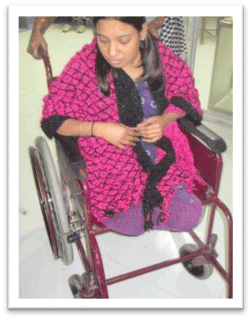
Figure 1. Bilateral Transfemoral Amputee on wheelchair.
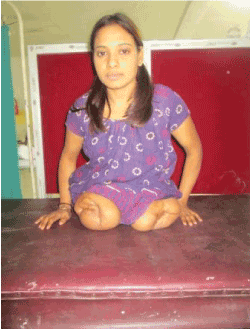
Figure 2. Bilateral Transfemoral Amputee.
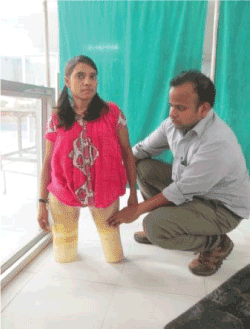
Figure 3. Balancing on stubbies.
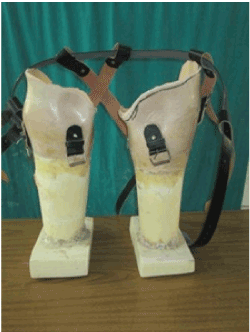
Figure 4. Stubby Prosthesis.
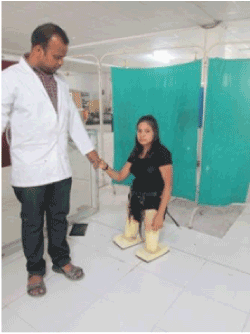
Figure 5. Gait training with stubbies on plane surface.
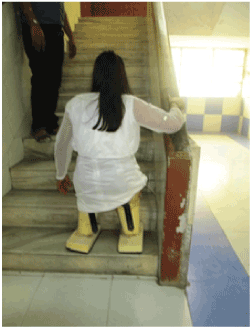
Figure 6. Stair Climbing with stubbies.
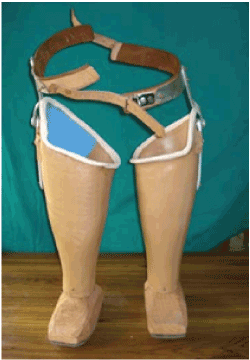
Figure 7. Final shape of Stubbies.
The data of prosthetic walking was assessed by Cosmed k4b2 metabolic analyzer system (COSMED Srl – Italy) for the measurement of Oxygen uptake (VO2), Carbon dioxide output (VCO2) and Heart rate after 4 weeks of successful training at different levels without help of any assistive gadgets (Figure 8). Initial first 8 minutes data were collected during walking in plane surface and in an additional brief information for about 8 minutes were gathered during step climbing. Information Collected during both walking in plane surface and stair climbing with 30 minutes of rest in between of both the errands.
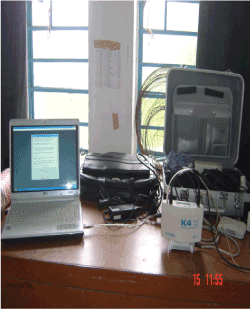
Figure 8. K4b2 System Respiratory Analyser System.
Result of this case report was analyzed with comparison of the client’s parameters with normal-abled subject parameters. The results of Oxygen uptake (VO2), Carbon dioxide output (VCO2) and Heart rate are summed up in Table 1.
Table 1. Result of this case report was analyzed with comparison of the client’s parameters with normal-abled subject parameters.
TEST |
OXYGEN UPTAKE (VCO2) |
Carbon dioxide output (VCO2) |
HEART RATE (BEATS/MIN) |
Client |
Normal Subject |
Client |
Normal Subject |
Client |
Normal Subject |
Walking on Level Surface |
352.06 |
241.1 |
270.8 |
157.12 |
146 |
122 |
During Stair Climbing |
468.76 |
289.7 |
365.4 |
217.9 |
168 |
159 |
The result of the present case report shows that no doubt there is a more energy expenditure in all the level of surfaces compared to the normal subject however there is no such difference with the client because of the activeness of the client. During Walking in plane surface, it was found that the VO2 uptake rate in bilateral trans-femoral amputee was 46% higher than the normal able bodied, similarly during stair climbing, VO2 uptake rate in bilateral trans-femoral amputee was 62% higher than the normal able bodied. Similarly, Carbon dioxide output (VCO2) of client recorded during walking in level surfaces and stair climbing was 72% and 68% more than the Normal abled subject. In the same manner heart rate is also increasing.
The human body has evolved an efficient locomotor system and any deviations from normal gait pattern increase the energy cost of walking. The result of the present study shows statistically significant between the two groups which say that in bilateral trans-femoral amputee the metabolic cost index is quite higher than the normal able bodied. In results it was found that the VO2 uptake, Heart rate and VCO2 comparisons were highly significant for both bilateral trans-femoral amputee and normal able bodied in walking(p<0.05) and also in stair climbing(p<0.05) condition. This suggests that the change in VO2 uptake can directly affects the HR and vice-versa [4]. This well-established fact had been employed in many previous studies of the energy costs of both bilateral trans-femoral amputee and normal able bodied. (Cordrey et al., Ganguli and Bose, McBeath et al., Dounis et al., Ghosh et al., Fisher and Patterson, Hinton and Cullen) [5].
From the current study it reveals that the VO2 uptake, VCO2 and HR is higher in the bilateral trans-femoral amputee using stubbies than the normal able bodied. This result accords with the literature led by Crouse et al [6], on their study they compared heart rate, oxygen uptake, and minute ventilation during treadmill ambulation of bilateral trans-femoral amputee subject using stubby and full-length prostheses to three able-bodied control. During testing, treadmill speed was increased every 3 min, until volitional exhaustion. This study found that ambulation with stubbies was more energy efficient than ambulation with full-length prostheses. Oxygen uptake was 24% higher, minute ventilation was 32% higher, and heart rate was 14% higher when the subject ambulated with full-length prostheses. When comparing the subject with bilateral trans-femoral amputee while wearing stubbies to controls, heart rate was 33% higher, oxygen uptake was 47% higher, and minute ventilation was 29% higher. While wearing full-length prostheses, heart rate was 52% higher, oxygen uptake was 80% higher, and minute ventilation was 70% higher than in the control subjects [7].
The findings of the study also support the literature of Hoffman et al. [8], Huang et al., they compared energy consumption for unimpaired subjects, unilateral below-knee amputees, unilateral above-knee amputees, and subjects with bilateral trans-femoral amputee. Patients walked at a self-selected walking speed, and energy consumption was measured by indirect calorimetric. Compared to unimpaired subjects, mean oxygen consumption was 28% higher in Bilateral trans-femoral amputee patients, which is significantly greater than mean oxygen consumption for unilateral below-knee amputees (9% higher than unimpaired subjects) and unilateral above-knee amputees (49% higher than unimpaired subjects). Taken collectively, these five studies support the fact that ambulation requires significantly greater energy for a patient with bilateral trans-femoral amputee. This greater energy requirement can discourage patients with bilateral-trans-femoral amputee from ambulating with prostheses, particularly in the face of advanced age and other co morbidities [9].
In walking condition, the result of the study showed that there is an increase of 56% higher oxygen consumption, 42% higher Heart Rate and 40% higher energy expenditure in bilateral trans-femoral amputee with stubby than normal population. This might have happened due to the readjustment in autonomic nervous activity apparently carried out and/or the cardiac contractile force might have increased in the walking condition. Oxygen consumption and EE in bilateral trans-femoral participants showed a tendency to increase with walking than metabolic rest condition. This literature also supported by Orendurff et al, Huang et al., described that Patients with bilateral trans-femoral with stubby consume higher level of oxygen and EE to perform same intensity of work as compared to normal population [6].
In Stair climbing condition the result of the study showed that there is an increase of 62% higher oxygen consumption, 40% higher Heart Rate and 80% higher energy expenditure in bilateral trans-femoral amputee with stubby than normal population. This might have happened due to, in stair climbing the concentric action of muscle requires more potential energy than in walking on the plane surface. The increase in oxygen cost for stair climbing probably results from additional energy to resist or brake the body from gravity’s pull while trying to achieve a proper and safe walking rhythm.
Both Lowenthal’s and associates [10] and McKenzie [11] have used stubby prostheses as training devices to determine whether prosthetic ambulation is a feasible goal. In one of Lowenthal’s five cases it was elected to progress to full-length prostheses; the patient’s gait was more labored and his endurance reduced, but it was believed that the patient’s improved morale was sufficient compensation for these losses. Of McKenzie’s 38 bilateral transfemoral amputee patients, 14 became successful stubby users, but of these, only 5 were able to progress to full-length articulated prostheses. It would appear that stubby prostheses will serve as the prostheses of choice in most patients [10].
A patient recouping from bilateral trans-femoral amputee faces numerous difficulties. Ambulation with prostheses (stubbies) after bilateral-trans femoral amputation requires critical energy use and results in a slower walking speed than normal. Based on the findings of this analysis, it very well may be inferred that Stubbies are moderately simple to utilize, similarly physiological comfort in correlation with full height prosthesis and take into account relative simplicity of gait with less energy cost to the amputee.
Indeed, utilizing stubbies can diminish pulse and oxygen use by 7 to 23 percent and can speed up by up to 25 percent. They are especially useful in the beginning phases of recovery, since they can assist with forestalling contracture or potentially abduction and advance recuperating in the residual limb. In spite of the fact that stubbies are commonly utilized as preparing device to decide an amputee's capacity to move in a limited confined area., it’s being used every day by such amputees all over the world.
Along these lines the utilization of stubbies is a safe, handy and successful strategy for improving gait with less energy consumption in her early rehabilitation program. It has likewise a clinically huge impact on the indoor mobility of amputees.
- Figueroa C, Rivera D, Wainapel SF (1980) Table to facilate donning stubby prostheses by bilateral above knee amputee. Phys Ther 60: 909-911. [Crossref]
- Lowenthal M, Posniak AO, Tobis SJ (1958) Rehabilitation of elderly double above-knee amputee. Arch Phys Med Rehabil 39: 290-295. [Crossref]
- Gonzalez EG, Corcoran PJ (1994) Energy expenditure during ambulation, In: Downey JA, Myers SJ, Gonzalez EG, Lieberman JS. The physiological basis of rehabilitation medicine. 2nd (edn). Boston: Butterworth-Heinemann.
- Herbert LM, Engsberg JR, Tedford KG, Grimston SK (1994) A comparison of oxygen consumption during walking between children with and without below-knee amputations. Phys Ther 74: 943-950. [Crossref]
- Parvataneni K, Ploeg L, Olney SJ, Brouwer B (2009) Kinematic, kinetic and metabolic parameters of treadmill versus overground walking in healthy older adults. Clin Biomech (Bristol, Avon) 24: 95-100. [Crossref]
- Crouse SF, Lessard CS, Rhodes J, Lowe RC (1990) Oxygen consumption and cardiac responses of short-leg and long-leg prosthetic ambulation in a patient with bilateral above-knee amputation: comparisons with able-bodied men. Arch Phys Med Rehabil 71: 313-317. [Crossref]
- Taylor MB, Clark E, Offord EA, Baxter C (1996) A comparison of energy expenditure by a high level trans-femoral amputee using the Intelligent Prosthesis and conventionally damped prosthetic limbs. Prosthet Orthot Int 20: 116-121. [Crossref]
- Hoffman MD, Sheldahl LM, Buley KJ, Sandford PR (1997) Physiological comparison of walking among bilateral above-knee amputee and able-bodied subjects, and a model to account for the differences in metabolic cost. Arch Phys Med Rehabil 78: 385-392. [Crossref]
- Huang CT, Moore NB, Jackson JR, Fine PR, Kuhlemier KV, et al. (1977) Energy cost of ambulation for amputees: Study using mobile automatic metabolic analyzer. Arch Phys Med Rehabil 58: 521.
- Lowenthal M, Posniak AO, Tobis JS (1958) Rehabilitation of the elderly double above-knee amputee. Arch Phys Med Rehabil 39: 290-295. [Crossref]
- Brooks D, Parsons J, Hunter JP, Devlin M, Walker J (2001) The 2-minute walk test as a measure of functional improvement in persons with lower limb amputation. Arch Phys Med Rehabil 82: 1478-1483. [Crossref]
Editorial Information
Editor-in-Chief
Martin Grabois
Baylor College of Medicine
Article Type
Research Article
Publication history
Received: November 18, 2020
Accepted: November 30, 2020
Published: December 09, 2020
Copyright
©2020 Behera TP. This is an open-access article distributed under the terms of the Creative Commons Attribution License, which permits unrestricted use, distribution, and reproduction in any medium, provided the original author and source are credited.
Citation
Behera TP, Jayavant S (2020) Efficacy of stubbies in initial phase of rehabilitation for a woman with bilateral transfemoral amputation - a case study. Phys Med Rehabil Res. 5. DOI: 10.15761/PMRR.1000218
Corresponding author
Tapas Priyaranjan Behera
Department of Prosthetics & Orthotics, Pt. Deendayal Upadhyaya National Institute for persons with Physical Disabilities (Divyangjan), New Delhi-110002
E-mail : bhuvaneswari.bibleraaj@uhsm.nhs.uk








